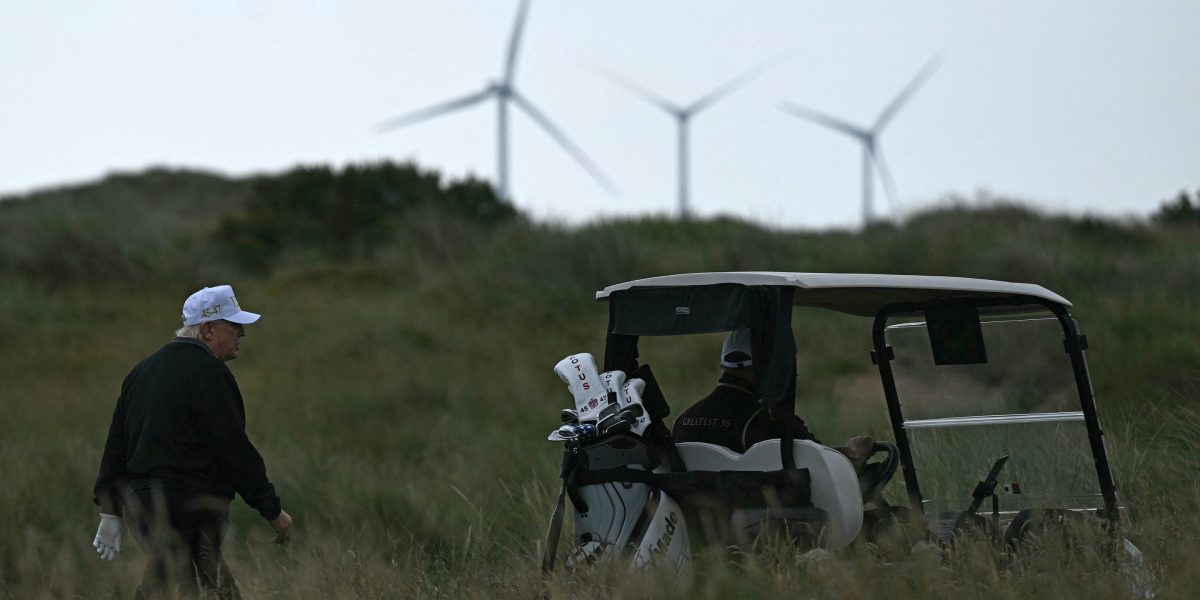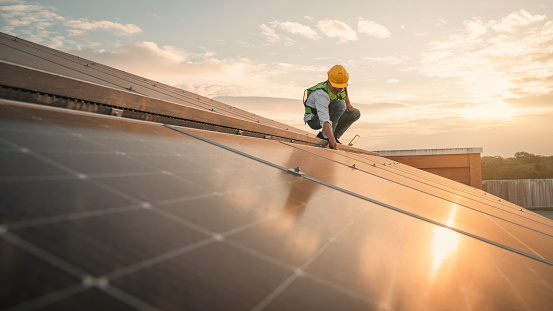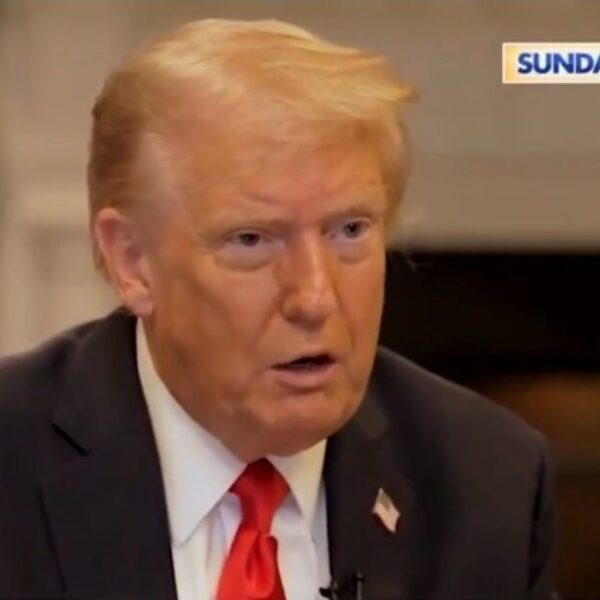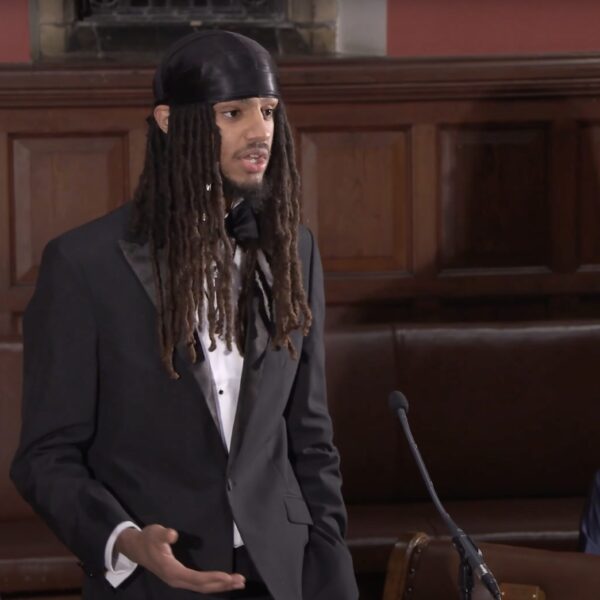A nearby offshore wind farm was already planned when Donald Trump purchased coastal land in northern Scotland to develop the Trump International Golf Links—a project he envisioned as an homage to his Scottish-American mother, Mary Anne MacLeod Trump.
“I am not thrilled. I want to see the ocean; I do not want to see windmills,” Trump told BBC News in May 2006. It was the first-known example of Trump’s years-long war against wind power.
It took another five years for the Aberdeen Offshore Wind Farm to initiate permitting and, in 2012 as the golf course was nearing its opening, Trump launched an all-out media and legal assault against the wind project—a campaign that proved unsuccessful. “Tourism will suffer and the beauty of your country is in jeopardy,” Trump warned in a 2012 advertisement.
Trump wrote in a 2013 Daily Mail article that he would fight “for as long as it takes—to hell if I have to—and spend as much as it takes to block this useless and grotesque blot on our heritage.” By the time he was first running for president in 2015, Trump had tweeted negatively about wind or “windmills” more than 130 times.
Much to Trump’s chagrin, the Scottish wind farm opened in 2018. But he’s carried that fight much more aggressively in his second term as U.S. president.
Upon his return to Scotland this July, he emphasized: “We will not allow a windmill to be built in the United States. They’re killing us”. Trump added Aug. 20 on Truth Social that he “will not approve” wind or solar projects. “The days of stupidity are over in the USA!!!” he posted.
While Trump may not prevent every new wind turbine installed in the U.S., he certainly is trying.
Apart from a rapid phasedown of tax credits for wind and solar projects in the One Big Beautiful Bill signed into law in July, the Trump administration has ramped up its attacks on wind—and solar—into a full-scale war, including all but banning new wind and solar projects on federal lands and waters, keeping wind turbines away from highways and railroads, investigating turbines for eagle deaths, and, most recently, making it harder for renewables to even qualify for the short-lived credits eliminated after 2027.
Potentially most onerously, wind or solar projects must now go through three levels of federal review, including personally by Interior Secretary Doug Burgum, who said in August that “gargantuan, unreliable, intermittent energy projects hold America back from achieving U.S. energy dominance.” These secretary-level reviews include many proposed on private land. Earlier this month, the administration canceled the massive Lava Ridge Wind Project in Idaho, yanking permits approved last year.
While Trump has long despised wind turbines, he’s only made it a top political priority in 2025. More wind projects were built during Trump’s first term than during the Biden administration. It’s only now though that U.S. power demand is surging—thanks to the AI data center boom—and it’s happening just when renewable energy is being handicapped.
Average electricity bill costs are up 7% year over year as of May, according to the Department of Energy, and they’re projected to keep rising.
“It’s a triumph of polarization over pragmatism,” American Clean Power Association CEO Jason Grumet told Fortune. “What is mind-boggling is that, after eliminating the subsidies, the administration has then gone on the attack with federal mandates and buckets of red tape to actively oppose projects being built.”

Executive ‘double-cross’
The last-minute compromise in the “Big Beautiful Bill” focused on keeping the renewable energy tax credits in place for now—but quickly phasing them out.
To qualify, projects must break ground by July 4, 2026, or be completed by the end of 2027. The key is really on breaking ground by next summer because few started after July 2026 are likely to finish by year-end 2027.
As soon as the omnibus spending law was passed, the Trump administration went to work making it harder to qualify for the tax credits—specifically what counts as breaking ground. Those revised rules were finalized on Aug.15.
It used to be that developers only had to pay 5% of the costs up front to lock in the tax credits. Instead, the 5% rule is eliminated for all but small solar farms, requiring all others to demonstrate that “physical work of a significant nature” has begun on or off-site, such as foundation excavation.
Grumet calls it a “double-cross” to immediately change the rules after reaching a deal that was already tough on the clean power sector. “This is basically an ‘America Last’ energy policy,” he said.
The fear was the administration would change the rules even more dramatically, but some Republican senators—including John Curtis of Utah and Chuck Grassley of Iowa—threatened holds on confirming some Trump nominees until the rules were released. After all, most new wind and solar farms are being built in so-called red states.
Also troublesome for the industry are new foreign-sourcing rules that penalize projects for using Chinese parts in a renewables industry dominated by Chinese supply chains.
Other regulatory aspects are potentially worse for the industry too. For instance, Burgum’s Interior Department went a step further on Aug. 1 to also include “enhanced” reviews for power line transmission projects that are deemed to help enable wind or solar projects.
That order came days after the Energy Department revoked a loan guarantee for the 800-mile Grain Belt Express transmission project from Kansas to Indiana.
Christina Hayes, executive director of Americans for a Clean Energy Grid, told Fortune that the transmission policy move adds more “uncertainty” when the nation rapidly needs more power infrastructure, especially when power lines are agnostic to electricity generated by wind or coal burning.
“There’s no sorting hack for electrons. Once an electron is on the system, it is like all the other electrons,” Hayes said, proceeding to make a Harry Potter reference. “It’s not like, ‘Oh, you’re a Gryffindor electron, you’re a renewable electron, you’re Hufflepuff, you’re coal.’ That’s not how this works.”
Rising obstacles
Potentially the most insidious changes for wind and solar aren’t the outright policy revisions, but the behind-the-curtains roadblocks created: federal websites going dark, meetings canceled, phone calls repeatedly unanswered.
“In order to permit a project, you have to interact with the federal government,” Grumet said. “You’re a developer, and you’ve gone through your 63 of 64 steps, and suddenly you can’t get your final meeting. And now future permits are going to be politicized at the cabinet secretary level for everything from where you put a fence to how you create a road. It’s weaponizing bureaucracy to undermine American energy production.”
For instance, Hayes said Elon Musk’s DOGE cuts contributed to the Energy Department’s staffing for the Coordinated Interagency Transmission Authorizations and Permits Program (CITAP) shrinking from about 60 people to six—critical for transmission siting and permitting.
Grumet likened the process to going to the Department of Motor Vehicles in the 1950s-era Soviet Union. “The government is challenging enough when everyone is working towards solutions; it’s impossible when the government is working to create problems.”
All the false claims
Trump has repeatedly called “windmills” a green energy scam and accused them of killing birds and marine life. He’s even falsely said the noise can cause cancer. But mostly, he loathes wind turbines for their aesthetics.
On the other hand, air pollution from fossil fuels can be carcinogenic, and the U.S. Fish and Wildlife Service has found that oil pits cause three times more bird deaths than wind turbines, which were deemed responsible for fewer than 0.01% of human-caused bird fatalities.
Outside of, yes, cats, the leading cause of bird deaths is building and glass collisions, including Trump’s towers in New York and around the world. Trump’s Aberdeen golf complex also was built on sand dunes that housed multiple species of endangered birds.
“The American public sees past the idea that a wind blade is a carcinogen,” Grumet said. “The issue the president really focuses on is the aesthetics. That’s a matter of personal opinion if the president thinks that staring at a natural gas facility is a source of American beauty, and staring at a wind turbine is an assault on the landscape.”
So, why now? One, this Trump administration is more filled with partisan players who were prepared to hit the ground running. Two, the energy fight increasingly has become more politically biased.
“Between 2020 and 2024, I think the whole energy debate became more partisan, and wind power, in particular, got locked into the ‘us versus them’ imagination of the way America works,” Grumet said.
Yes, it’s a tough time for renewable energy in America. Fewer projects will come to fruition. The extent of that decline is unclear. But new natural gas-fired plants and nuclear facilities will take five to 10 years to build. Retiring coal plants will have their lives extended, but only temporarily. New power generation is needed more quickly, and renewables, especially solar power, will still fill most of the short-term gap—with or without tax credits.
“We are inexorably moving toward a more efficient, lower-carbon energy system,” Grumet said. “The president’s actions certainly could slow that down for a couple years, but the direction is not going to change.”














